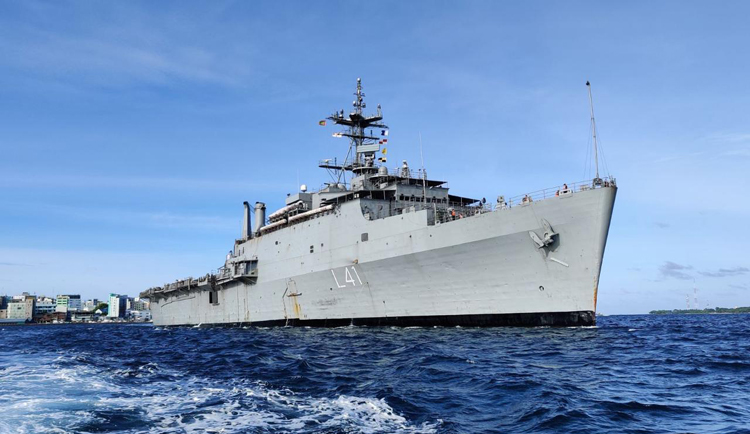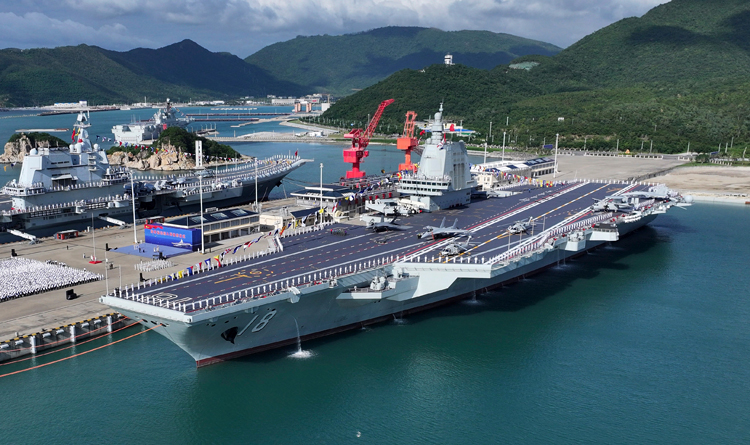INDIAN ARMED FORCES CHIEFS ON OUR RELENTLESS AND FOCUSED PUBLISHING EFFORTS

The insightful articles, inspiring narrations and analytical perspectives presented by the Editorial Team, establish an alluring connect with the reader. My compliments and best wishes to SP Guide Publications.

"Over the past 60 years, the growth of SP Guide Publications has mirrored the rising stature of Indian Navy. Its well-researched and informative magazines on Defence and Aerospace sector have served to shape an educated opinion of our military personnel, policy makers and the public alike. I wish SP's Publication team continued success, fair winds and following seas in all future endeavour!"

Since, its inception in 1964, SP Guide Publications has consistently demonstrated commitment to high-quality journalism in the aerospace and defence sectors, earning a well-deserved reputation as Asia's largest media house in this domain. I wish SP Guide Publications continued success in its pursuit of excellence.
- Operation Sindoor: Resolute yet Restrained
- Advanced MRSAM for India for a greater firepower
- Japan and India set forth a defence cooperation consultancy framework, talks on tank and jet engines
- Uri, Pulwama and now Pahalgam
- Terrorist Attack in Pahalgam in Kashmir: Unfolding a long surgical war against PAK
Indigenous LPDs for Indian Navy
The proposal to procure four indigenous advanced LPDs is a major step towards bolstering the Indian Navy's maritime strength and strategic autonomy
 |
The Author is Former Director General of Information Systems and A Special Forces Veteran, Indian Army |

According to news reports of September 23, 2025, the Indian Navy plans to float ₹8,000 ($9.58 billion) crore tender for four indigenous, advanced Landing Platform Docks (LPDs) to boost amphibious warfare and maritime command capabilities. These modern warships, which will support fixed-wing drones and act as command centres, are expected to significantly enhance India's ability to conduct expeditionary operations, humanitarian aid, and strategic maritime support. The tender is a key step in modernising the navy's amphibious fleet, with bids anticipated from major Indian shipyards like Cochin Shipyard and L&T.
LPDs are designed to transport and support combined-arms expeditionary forces. An LPD features a flight deck on the upper level for operating helicopters, drones, and VTOL (Vertical Take-Off and Landing) fighters, and a well dock on the lower level for carrying amphibious craft and ground mobility vehicles, both soft-skinned and armoured. By ballasting the stern, the ship can partially submerge the well dock, enabling amphibious vessels to dock or undock directly from the sea.
These modern warships, which will support fixed-wing drones and act as command centres, are expected to significantly enhance India's ability to conduct expeditionary operations, humanitarian aid, and strategic maritime support.
The planned LPDs are thought to be of 40,000-tonne displacement. The bidders are expected to base their designs on LPDs from foreign countries such as Russia, France, Spain, and Italy. The ships would be built and integrated at Indian shipyards. Naval Group has signed MoUs with Hindustan Shipyard Limited, Visakhapatnam, to support its bid for the Navy's LPD project.
Key aspects of the project include: Purpose – to build state-of-the-art LPDs for enhanced amphibious assault, humanitarian relief, and expeditionary operations; Cost -the tender is estimated to be worth around ₹8,000 crore; Capabilities – the new LPDs will be equipped to operate fixed-wing naval drones, serve as command-and-control hubs, and provide advanced air defence and offensive capabilities; Indigenous Focus – the project aims to boost indigenous shipbuilding, with Indian shipyards expected to build and integrate the vessels, potentially with foreign design partnerships; Bidders - major Indian shipbuilding firms, including Larsen and Toubro (L&T), Mazagon Dock Shipbuilders Limited. Cochin Shipyard, Garden Reach Shipbuilders and Hindustan Shipbuilders Limited are expected to compete; Modernisation - this initiative is a crucial part of modernising the Indian Navy's amphibious warfare fleet, addressing current gaps in capabilities.
By integrating unmanned jets and leveraging Manned-unmanned Teaming (MUM-T) operations with existing manned aircraft like the MiG-29K and Rafale (M), these platforms could transform the Indian Navy's operational flexibility, cost-efficiency and strategic reach.
The proposal to procure four indigenous advanced LPDs is a major step towards bolstering the Indian Navy's maritime strength and strategic autonomy. The proposal is expected to be reviewed by the Ministry of Defence (MoD) in a high-level meeting soon, with the tender likely to be issued in the following weeks. This initiative under 'Make in India' will ensure that the entire project will be handled by an indigenous firm.

The tender, once issued, would spell out the details and specifications required of the planned LPDs. Including the quantum and types of Unmanned Aerial Vehicles (UAVs) each LPD would house – taking a cue from Chinese UAV carrier vessels. UAVs could significantly bolster the Navy's Intelligence, Reconnaissance and Surveillance (ISR) and strike capabilities. By integrating unmanned jets and leveraging Manned-unmanned Teaming (MUM-T) operations with existing manned aircraft like the MiG-29K and Rafale (M), these platforms could transform the Indian Navy's operational flexibility, cost-efficiency and strategic reach. The UAVs would enable the Navy to maintain persistent ISR, enhance strike capability and support operations of our Carrier Battle Groups (CBGs).
The UAV complement could operate independently or in tandem with the CBGs, extending the Indian Navy's operational reach across the Indian Ocean Region (IOR) from the Persian Gulf to the South China Sea (SCS).
The new LPDs could be equipped to operate a mix of fixed wing UCAVs, rotary-wing drone, and swarming drones, in addition to fixed wing manned fighter jets. The UAV complement could operate independently or in tandem with the CBGs, extending the Indian Navy's operational reach across the Indian Ocean Region (IOR) from the Persian Gulf to the South China Sea (SCS). In contested environments and anti-ship missile zones UAVs eliminate the risk to human pilots, preserving valuable manned assets for critical missions. Moreover, UAVs can optimise the interoperability within the QUAD members, with the US having deployed UAVs, as well as with the French Navy which is using unmanned systems. A specific UAV complement in LPDs is more economical than building separate UAV carrier ships.
The Indian Ocean is a critical theatre for India's maritime security, given its role in global trade routes, energy supply chain, and the increasing presence of regional and extra-regional powers, including China's expanding naval footprints. The irony is that our Navy and Air Force are far behind the capabilities of China, and our defence allocations are far below the required investments in defence. Moreover, with the focus on elections, we are yet to find the requisite balance between economy and national security.
China's People's Liberation Army Navy's (PLAN) has officially commenced construction of the Type 004 nuclear-powered super carrier, displacing between 1,10,000 and 1,20,000 tonnes, making it potentially the largest in the world
Our policy makers no doubt are keeping a tag on the rapidly advancing naval capabilities of China, but our approach to capability building should not be ad hoc. For example, the Indian navy had floated a request for information (RFI) way back in 2021 and we have already lost four years since then. China's Navy is already numerically larger than the US Navy and China aims to overtake the US Navy technologically in a few years from now.

According to news reports of September 30, 2025, China's People's Liberation Army Navy's (PLAN) has officially commenced construction of the Type 004 nuclear-powered supercarrier at the Dalian Shipyard; displacing between 1,10,000 and 1,20,000 tonnes, making it potentially the largest in the world, surpassing the US Navy's Gerald R. Ford. Defence analysts note that the vessel's displacement would allow it to host not only a larger air wing but also expanded command-and-control facilities, enabling it to function as a floating joint operations hub for the PLAN. Also, the Type 004 will integrate a new generation of phased-array radars and shipborne air-defence systems, potentially comparable to or exceeding the capabilities of the US Navy's Aegis combat system.
Taken together, these developments position the Type 004 not merely as another addition to the PLAN's fleet but as the strategic centrepiece of China's aspirations to conduct sustained, global, carrier-based power projection by the mid-2030s. The ship is also expected to adopt integrated electric propulsion (IEP), powering not only the propulsion system but also high-energy weapons such as directed-energy systems and electromagnetic railguns in the future.





